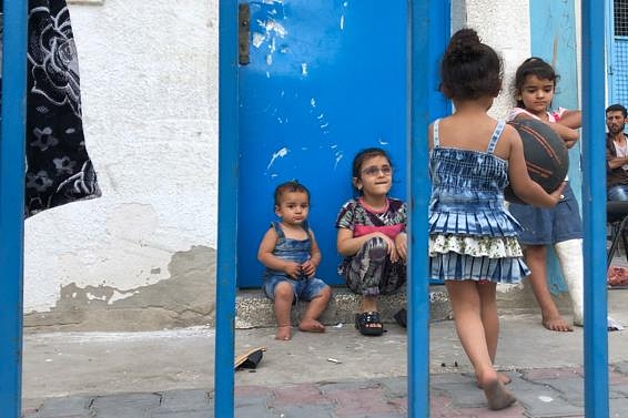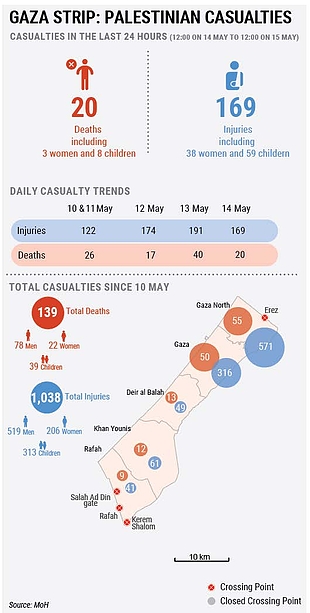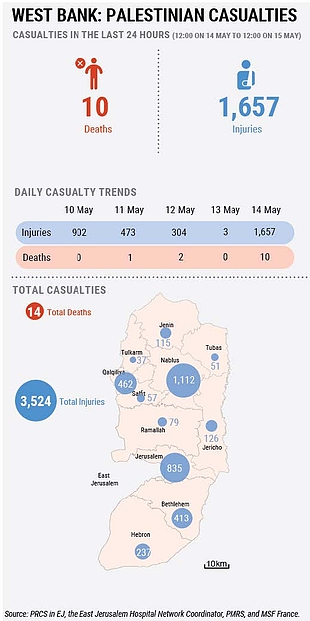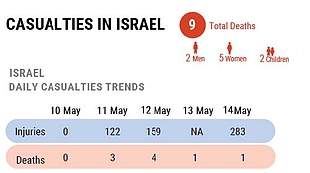Escalation in the Gaza Strip, the West Bank and Israel | Flash Update #5 as of 12:00 15 May 2021
- Hostilities between Israeli forces and armed groups in Gaza continued, resulting in further casualties. Between 10 May and 12:00 on 15 May, 139 Palestinians were killed in Gaza and 1,038 were injured, according to the Ministry of Health in Gaza. Hostilities have also resulted in significant additional displacement of Palestinians, with over 17,000 displaced persons in 41 UNRWA schools across Gaza.
- There was a significant escalation in the West Bank, including in East Jerusalem, with 10 Palestinians killed and over 1,650 injured as a result of clashes between Palestinians and Israeli forces.
- The death toll in Israel has risen to 10, one after the end of the reporting period, with hundreds injured, based on official data. Widespread civil disturbances have also continued in Israel.
- Referring to the deteriorating humanitarian situation in Gaza, the Humanitarian Coordinator, Lynn Hastings, appealed to “the Israeli authorities and Palestinian armed groups (to) immediately allow the United Nations and our humanitarian partners to bring in fuel, food, and medical supplies and to deploy humanitarian personnel. All parties must always adhere to international humanitarian and human rights laws.”

Situation overview
 Israeli forces continued to launch intensive strikes on multiple locations across the Gaza Strip, reportedly targeting armed groups and related infrastructure, and Palestinian armed groups continued extensive firing of rockets on Israel. As of 12:00 15 May, the health authorities in Gaza have reported the death of 139 people, including 39 children and 22 women, and injury to 1,038 people, including 313 children and 206 women, since the start of the escalation on 10 May. According to the Israeli authorities, some of the casualties and damage in Gaza may have resulted from Palestinian rockets falling short.
Israeli forces continued to launch intensive strikes on multiple locations across the Gaza Strip, reportedly targeting armed groups and related infrastructure, and Palestinian armed groups continued extensive firing of rockets on Israel. As of 12:00 15 May, the health authorities in Gaza have reported the death of 139 people, including 39 children and 22 women, and injury to 1,038 people, including 313 children and 206 women, since the start of the escalation on 10 May. According to the Israeli authorities, some of the casualties and damage in Gaza may have resulted from Palestinian rockets falling short.
In one incident, on the morning of 15 May, nine people including seven children (aged from five to 12), and two women were killed in an attack on a residential building in Beach Camp, west of Gaza City. Multiple sources indicated that the attack was not preceded by any prior warning.
The hostilities have also led to increased internal displacement. According to UNRWA, over 17,000 internally displaced people (IDPs) are present in 41 UNRWA schools, primarily in Gaza city and the Northern Gaza governorate. Of these, only 23 are Designated Emergency Shelters (DES), which have been previously prepared to cater for IDPs. Although UNRWA schools have been used as designated shelters in previous escalations of hostilities in Gaza, the agency warned “that we now have to consider the COVID-19 pandemic and how to minimize the risk of people crowding in a very confined space and spreading the virus.” Despite restrictions on staff movement and insecurity, “UNRWA is doing all it can to make sure these schools are safe enough for displaced people to stay and be supported.” UNRWA is preparing for possible opening of a number of DESs if required.
Extensive damage is reported to residential and commercial buildings, schools and infrastructure, including roads, electricity network and water installations and agricultural lands. Since the start of the escalation, the Ministry of Public Works and Housing reports that 76 buildings have been destroyed, and about 725 housing units have suffered major damage. In addition, 4,134 housing units have sustained minor damage. The Education Cluster reports that 36 education facilities, including schools, an UNRWA vocational training centre and a higher education facility have been affected since the start of the escalation.
 During the reporting period, only two of the ten electricity feeder lines from Israel to Gaza were functioning. Up to 500,000 liters of Egyptian imported fuel were delivered to Gaza’s sole power plant during the reporting period with more expected later today, this will enable the plant to continue to run on two turbines at least until next Tuesday. The current electricity supply from all sources reduced since the start of the hostilities from 190 to 70 MW, of an estimated total need of 400 MW. Power supply across Gaza has been reduced to six-eight hours per day on average, and to less than four in some areas, disrupting the provision of basic services, including water, sanitation, and healthcare.
During the reporting period, only two of the ten electricity feeder lines from Israel to Gaza were functioning. Up to 500,000 liters of Egyptian imported fuel were delivered to Gaza’s sole power plant during the reporting period with more expected later today, this will enable the plant to continue to run on two turbines at least until next Tuesday. The current electricity supply from all sources reduced since the start of the hostilities from 190 to 70 MW, of an estimated total need of 400 MW. Power supply across Gaza has been reduced to six-eight hours per day on average, and to less than four in some areas, disrupting the provision of basic services, including water, sanitation, and healthcare.
Water, hygiene and sanitation (WASH) infrastructure has also been severely affected, including wastewater networks, pipelines, water wells and a wastewater pumping station; some prioritized repairs are currently underway. The North Gaza Seawater Desalination Plant is not operational for the fifth successive day, which undermines the access of about 250,000 people to drinking water. For the third successive day, about 230,000 people from Gaza city and Khan Younis have limited access to piped water, due to increasing power cuts and damaged networks. Wastewater leaks in the streets are reported in Beit Lahia, Gaza city and Khan Younis.
The Israeli authorities have closed the Erez crossing since 10 May, including for humanitarian aid and personnel, and the Kerem Shalom goods crossing, including for fuel essential for the operation of the Gaza power Plant. All fishing activity remains prohibited off the Gaza coast. The Rafah crossing and Salah Ad Din gate with Egypt are closed due to the Muslim holiday of Eid al Fitr.
According to Israeli sources, between 10 May and 14:30 on 15 May, Palestinian armed groups in Gaza fired more than 2,300 rockets and other projectiles into Israel. In the reporting period, such strikes caused damage to homes, livelihoods and infrastructure in the cities of Beersheba, Ashdod and Sderot, among other places. Warning sirens were reportedly heard in Kiryat Gat during the funeral of a five-year-old, who was killed two days previously when his home in Sderot was struck by a rocket. To date, ten people in Israel (including one after the reporting period), including one soldier, have been killed and hundreds injured.
 Following Friday prayers, and continuing until the late hours of 14 May, widespread clashes between Palestinians and Israeli forces broke out in multiple locations across the West Bank, including at checkpoints. These were fuelled by reports of solidarity demonstrations taking place by protestors in Jordan and Lebanon at their respective borders with Israel. Ten Palestinians were killed by Israeli forces, in addition to one Palestinian killed near Ofra settlement earlier in the day. This is the highest number of Palestinian fatalities that OCHA has recorded in a single day in the West Bank, including East Jerusalem, since 2008, when it began to systematically record casualties. Out of the eight deaths in different locations in the northern West Bank, three resulted from clashes with Israeli forces, which erupted following attacks by Israeli settlers on Palestinians. Attacks and stone-throwing by settlers against Palestinians also continued in southern West Bank.
Following Friday prayers, and continuing until the late hours of 14 May, widespread clashes between Palestinians and Israeli forces broke out in multiple locations across the West Bank, including at checkpoints. These were fuelled by reports of solidarity demonstrations taking place by protestors in Jordan and Lebanon at their respective borders with Israel. Ten Palestinians were killed by Israeli forces, in addition to one Palestinian killed near Ofra settlement earlier in the day. This is the highest number of Palestinian fatalities that OCHA has recorded in a single day in the West Bank, including East Jerusalem, since 2008, when it began to systematically record casualties. Out of the eight deaths in different locations in the northern West Bank, three resulted from clashes with Israeli forces, which erupted following attacks by Israeli settlers on Palestinians. Attacks and stone-throwing by settlers against Palestinians also continued in southern West Bank.
The reporting period recorded some 1,657 Palestinian injuries in the West Bank, including East Jerusalem, bringing the total of confirmed injuries since 10 May to 3,524, with the total of 14 fatalities in total. On 14 May, the Palestinian Ministry of Health made a public appeal for blood donations at government hospitals, due to the blood bank running out of supplies.
In East Jerusalem, the situation in Al Aqsa Mosque remains relatively calm, with minor clashes reported. Palestinians continue to protest the imminent eviction of Palestinians from the Al Jaouni area of Sheikh Jarrah, which remains blocked off by Israeli forces, with only Palestinians living in the neighbourhood allowed access, and protestors from outside subject to tear gas, stun grenades and ‘skunk’ water.
In Israel, inter-communal violence continues in multiple localities.
International law
In his most recent briefing to the Security Council on 12 May, the UN Special Coordinator Tor Wennesland stated that “Hamas and other militants’ indiscriminate launching of rockets and mortars from highly populated civilian neighbourhoods into civilian population centres in Israel violates international humanitarian law, is unacceptable and has to stop immediately. While recognizing Israel’s legitimate security concerns, Israeli authorities must also abide by their responsibilities under international law and Israeli security forces must exercise maximum restraint and calibrate its use of force to spare civilians and civilian objects in the conduct of military operations.
“There can be no justification for the killing of civilians anywhere. I am particularly appalled that children continue to be victims of violence. I reiterate that children should not be the target of violence or put in harm’s way. They should be afforded special protection from any form of violence.”
Humanitarian response & ongoing needs
Protection
West Bank, including East Jerusalem:Cluster partners are monitoring and documenting suspected violations and providing legal aid and child protection services, as well as mental health and psycho-social support (MHPSS). Of ongoing concern is the impact on children and youth in the context of growing civil unrest in Israel, as well as armed settler attacks in multiple parts of the West Bank, including East Jerusalem, deterring families from leaving their homes. Cluster partners are recording an increased use of live ammunition by Israeli forces and combat soldiers towards demonstrators, resulting in Palestinian fatalities and live ammunition injuries. Confrontations in the West Bank are increasingly of an armed nature. Cluster partners providing remote MHPSS services have registered a near double increase in calls from East Jerusalem to its national helpline, compared with the same period in the previous month.
Gaza: The Cluster continues to assess the impact on vulnerable groups, by monitoring, documenting, and reporting violations of international law. In particular, partners are assessing needs in North Gaza and providing remote psychological support through hotlines and mobile phones, and some of them have partially activated their contingency plans. Trained volunteers assisted the evacuation of persons with disabilities from their homes to safe emergency shelters and to the Indonesian hospital. All over Gaza, partners are supporting the provision of assistive devices, physical rehabilitation sessions, and psychosocial first aid for those in need. Remote psycho-social counselling through hotlines and mobile phones and Explosive Remnants of War (ERW) risk awareness messaging through online platforms and social media are continuing, as well as online information and emergency risk education for community members, including for parents/caregivers on handling stress and caring for children during emergencies.
Health
West Bank, including East Jerusalem:As protests continue across the West Bank, including East Jerusalem, cluster partners and community volunteers continue to treat a substantial number of injuries. Ambulances dispatched to support injuries in areas around Nablus were reportedly prevented access, resulting in injuries being treated in the field. Of growing concern is possible COVID-19 transmission in areas where demonstrations are being held. The Palestinian Ministry of Health (MoH) made a public appeal on 14 May for blood donations to government hospitals, as the blood bank is running out of blood supplies.
Gaza: Partners have been mobilizing resources to support the bombardment response and have committed to meet some of the needs presented by the Gaza health authorities. WHO conducted a visit to, Gaza’s largest hospital, Shifa, where most of the severely injured patients are being treated. The hospital has doubled its intensive care unit capacity to 18 beds and the caseload remains manageable for now. The continued closure of the crossings is impacting the referral of patients for lifesaving treatment outside of Gaza and preventing specialist surgical care emergency teams from entry. The ongoing insecurity is also impeding access to health services and hampering efforts to implement an optimum response to the COVID-19 pandemic, including the critical vaccination programme. There is also an increased risk of COVID-19 transmission as displaced people seek shelter with host families and emergency shelters.
Shelter
Gaza: According to the Ministry of Public Works and Housing, the bombing has resulted in 76 buildings totally destroyed, comprising 410 housing units and commercial facilities, in addition to 209 housing units with severe damage (uninhabitable), 137 with major damage and 4,134 with minor damage. Partners are trying to carry out detailed damage assessments and support the repair of homes with major damage, giving priority to vulnerable groups. According to UNRWA, as of this morning, at least 17,000 people sought shelter in 41 UNRWA schools, including 23 designated emergency shelters (DES), still not officially open as such. Shelter partners and the Ministry of Social Development (MoSD) have already started supporting some IDP families with Non-Food items. Due to damage to power lines and fuel shortages, power supply across Gaza has been reduced to six-eight hours per day on average and in some areas to less than four hours.
Water, Sanitation and Hygiene (WASH)
Gaza: WASH Infrastructure has been severely affected, including wastewater networks, pipelines, sewage evacuation vehicles, four water wells and a wastewater pumping station due to damages, lack of power and difficult access. The service provider and the municipalities are currently carrying out some urgent repairs. The North Gaza Seawater Desalination Plant is still not operational and affecting about 250,000 people. In Beit-Lahia, sewage and solid waste are accumulating in the streets after the damage of carrier sewage line and solid waste vehicles. 230,000 people from Gaza City and Khan Younis are still for the third successive day having limited access to piped water due to increasing power cuts and damage to the networks. Wastewater networks in Beit Lahia, Gaza City and Khan Younis were damaged, resulting in wastewater flows in the streets, and no substantial repairs have taken place yet. The municipality of Gaza appealed for supporting the provision of municipal services which have been disrupted such as solid waste management, water and sanitation networks. In general, there is a reduction of up to fifty per cent in WASH services.
Education
West Bank, including East Jerusalem: Schools in the West Bank, including East Jerusalem, are closed for the Muslim holiday of Eid al Fitr from 11 to 15 May. Should the situation escalate, they may not re-open, a decision as not been taken yet at the time of reporting. In the coming days, cluster partners are scaling up their mental health and psycho-social support (MPHSS) and the monitoring of education-related violations.
Gaza: Some 36 education facilities and a MoE directorate building have been affected so far, including schools, an UNRWA vocational training center, one MoE directorate building and a higher education facility have been impacted since the start of the escalation. Reports indicate that a number of these schools were directly hit by airstrikes or tank shells. 41 UNRWA schools have been reportedly used as temporary shelters by displaced people. Partners are scaling up distance learning support, remote MHPSS interventions, the delivery of emergency education supplies to displaced children, and will start resource mobilization to rehabilitate damaged education facilities
Food Security
Gaza: Large agricultural areas and several agricultural facilities such as farms, greenhouses, water wells, have been damaged or disrupted, decreasing agricultural production. The situation will be assessed as soon as the situation allows. The closure of Kerem Shalom crossing point has decreased animal fodder availability in the market. The current stockpile should be sufficient for one day only, while 600 tons are needed to daily feed poultry and the livestock. Privately owned fodder for between five to seven days is reportedly stored at Kerem Shalom, ready to be imported. The Ministry of Agriculture warns that the impact on the livestock and poultry sectors will adversely impact the main protein source of the Gaza population. The World Food Programme (WFP) is monitoring the prices and availability of goods in the markets. The price of basic food commodities has remained stable. The MoSD has shared a list of 1,000 displaced families who need food assistance and WFP is providing 354 families with immediate assistance through electronic vouchers. WFP’s cash-based transfer platform is available and ready for use by other humanitarian actors. Partners are continuing to assess the food needs of displaced people.









